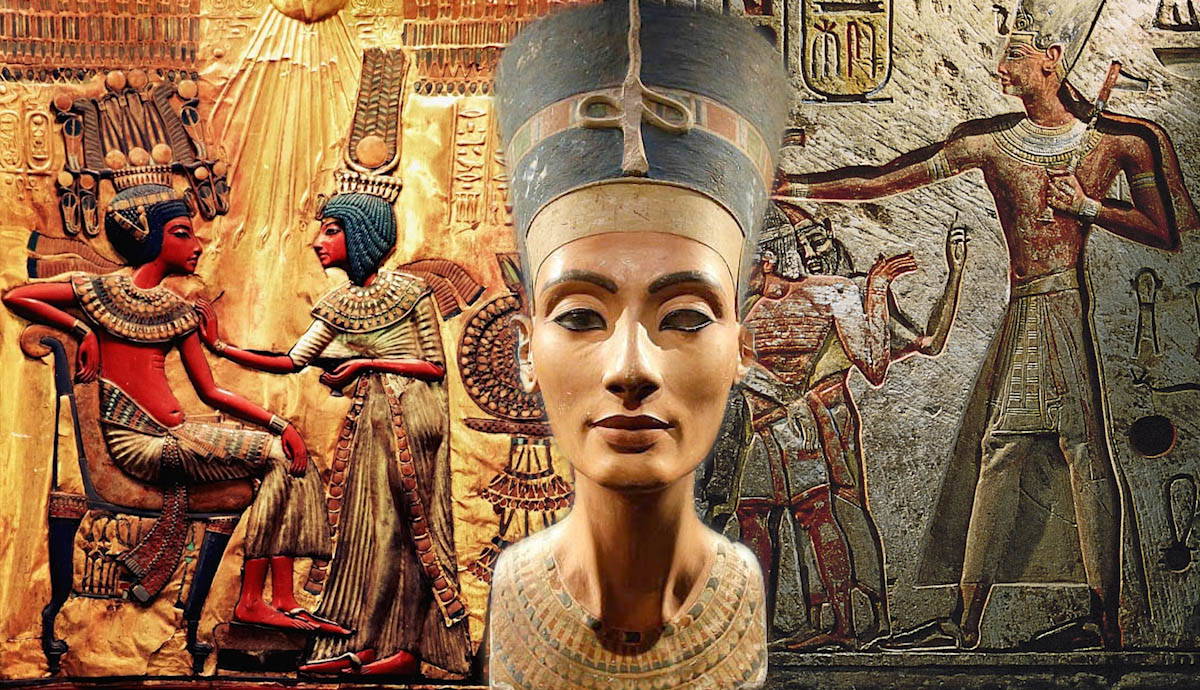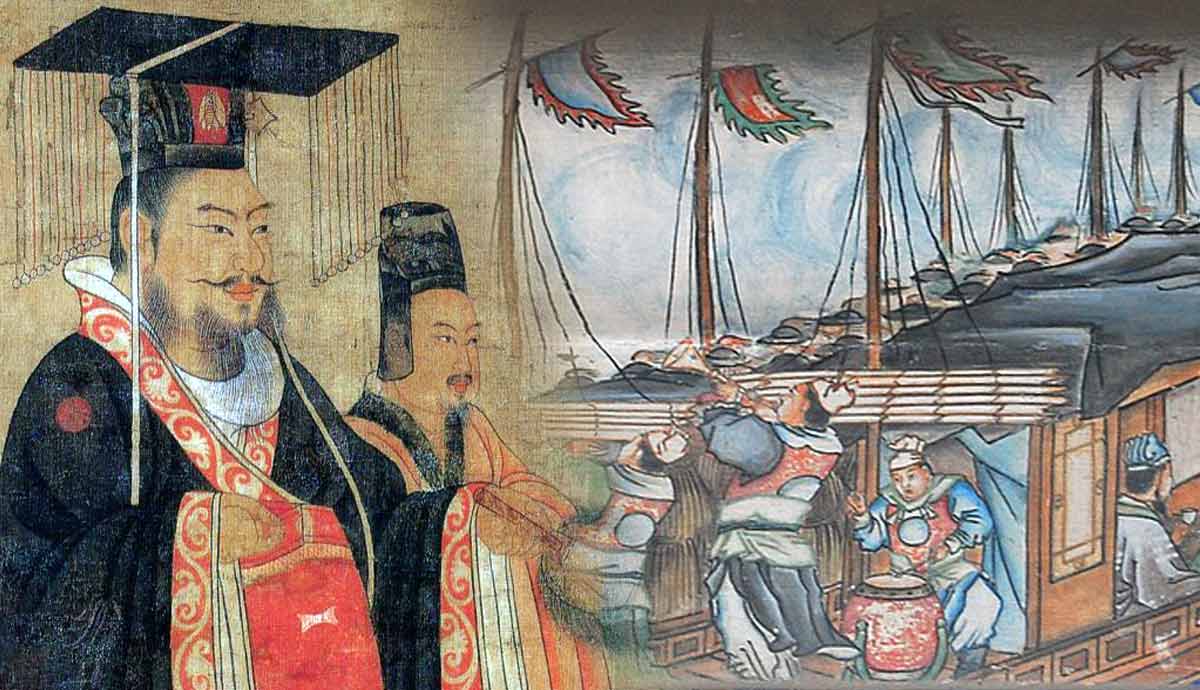
The love song quoted below wasn’t written today, but more than 3,000 years ago during ancient Egypt’s New Kingdom Period(1292–1069 BCE). The song, taken from the Chester Beatty Library papyri collection, shows that the ancient Egyptians loved and expressed their love with the same emotions as modern people. This article will delve deep into the long history of ancient Egypt to discover five of the greatest love stories that have stood the test of time — from the courtly love of kings and queens to the magical love stories found in Egyptian mythology.
“My heart bares itself instantly,
at the memory of your love.
It does not let me walk like a person,
it has strayed from its shelter.
….My health-cure is her visit,
has she gazed, then I am well,
has she opened her eyes, then my body is young,
has she spoken, then I am strong.
When I embrace her, she has banished harm from me…”
1. Love That Left its Mark on Ancient Egypt: Ramesses the Great and Nefertari

Perhaps one of the most enduring love stories from Ancient Egypt is the marriage between Ramesses II or Ramesses the Great (1279–1213 BCE) and his Queen Nefertari, also known as Nefertari Meritmut. Nefertari means “beautiful companion” and Meritmut means “beloved of the mother goddess Mut”. The origins of Nefertari and her relationship with Ramesses the Great are unknown. However, we know that, like other kings of Egypt, Ramesses the Great had a large harem of wives but only one wife was bestowed with the title “chief queen”. Ramesses the Great had eight of these chief queens during his reign, but Queen Nefertari was his first and the one who left the most significant impression on the King.

Ramesses and Nefertari were wed in 1312 BCE, and soon after, the new Queen gave birth to the first of eleven heirs. We know little of Nefertari’s origins and of her time as Queen, but what we do know is that after her death, Ramesses committed vast resources, care, and attention towards making sure that his first wife’s memory was never forgotten.
Ramesses the Great’s affection for his first chief Queen can be seen painted on the walls of her lavish tomb at the Valley of the Queens. The tomb’s decorations emphasize Nefertari’s personality and intellect, with the Queen depicted conversing with officials and playing the game Senet. The paintings of her face still shine with radiance after thousands of years, and it is clear that the artist gave her features careful attention to accentuate her beauty. Scholars consider these decorations to be some of the best-preserved and most artistic decorations of any Egyptian burial site ever found. Nefertari’s tomb shows us the deep respect and reverence Ramesses the Great had for his first wife.
As well as her lavish tomb, Ramesses the Great ordered the construction of temples to honor Nefertari at Abu Simbel. These colossal temples were built with the same love as her tomb and they were designed to fill any visitor with awe. Two groups of statues flank the temple’s exterior, with a large entranceway in between. The figures on the right depict Ramesses the Great and his Queen standing side by side.

What makes Nefertari’s temple so unique is that it remains one of the very few instances in Egyptian architecture in which both statues of the king and his queen are equal in size. In other temples, the Queen’s statue was never taller than that of their king. This shows that Ramesses the Great thought of his wife so highly that he ordered her statue to have the same importance and height as his.
2. Love Eternal: Tutankhamun and Ankhesenamun

Tutankhamun is perhaps the most famous king of Egypt and he is best known for his intact tomb discovered in 1922 by an excavation team led by Howard Carter. Tutankhamun (1336-1327 BCE) worked to restore stability in his realm throughout his brief reign, after his predecessor, Akhenaten, left the region in turmoil. He reigned alongside his wife Anksenamun (c. 1350 BCE) and the depictions in his tomb of them together are perhaps the most striking depictions of romantic love in ancient Egypt.
Ankhsenamun is always pictured with her husband, though this was not uncommon for the time. What makes these depictions so unique is their devotion to each other by their proximity, hand gestures, and facial expressions. In the art that fills the young King’s tomb, we can feel the strength of their bond. The Queen is depicted gifting her husband flowers and accompanying him on a hunting expedition.
Tutankhamun died just as he was entering adulthood, and mentions of his wife Ankhsenamun disappear from history shortly afterward. Despite this, the tomb decorations go a long way to telling us how strong their relationship was.
3. Tragic Love in Egyptian Mythology: Isis and Osiris

Ancient Egyptian mythology is full of fantastical tales, one of which is considered the first tragic love story in history — the story of the goddess Isis and her brother Osiris. Isis and Osiris were the children of the earth god Geb and the sky goddess Net. Despite being brother and sister, they were married, and they ruled ancient Egypt as king and queen.
In Egyptian mythology, Osiris and his brother Seth were fierce rivals. There are many differing accounts of the origins of this rivalry; some say that Osiris fought Seth or that he had an affair with Seth’s wife, Nephthys. Regardless of the cause of this rivalry, Seth enacted his revenge on Osiris by murdering him and mutilating his body, splitting it into 42 pieces that he scattered across the kingdom of Egypt. Seth then crowned himself the king.
Isis was left distraught at the death of her husband, and her sadness was compounded by the fact that she had not yet borne him an heir to carry on their mythological family line. So Isis and her sister Nephthys joined forces and searched the kingdom of Egypt for the 42 parts of Osiris. After a long search, Isis found every piece, and she took them to the Egyptian gods of death Anubis and Thoth, where they were fused back together.
The now complete body of Osiris was wrapped like a traditional mummy, and Isis conceived an heir with the corpse of Osiris. As a result of this unlikely coupling, a son Horus was born who avenged his father’s death. So, next time you think your love life is going through a rough patch, spare a thought for Isis and Osiris, who had to face death and dismemberment to be together.
4. Everyday Love: Meretites and Kahai

In 2012, at the burial ground of Saqqara, a team of archaeologists discovered a tomb dating back more than four millennia to Egypt’s Old Kingdom. The tomb contained the remains of a couple and their children. While it may seem like quite an ordinary discovery, what makes the tomb such a unique example of ancient Egyptian love are the intricate carvings that decorate the tomb.
After the tomb was fully excavated and studied, it was found to be the resting place of a singer from the Pharaoh’s retinue called Kahai, and his wife, a priestess Meretites. As a result of their royal connections, the tomb was decorated to a higher degree than others found at Saqqara. The unique carvings on the tomb walls depict people singing and playing music. Uniquely, one scene shows the couple gazing into each other’s eyes and Meretites affectionately placing her hand on her husband’s shoulder. This tells us of the love which Meretites and Kahai felt for each other and which they wanted to carry over to the afterlife.
Such depictions of love and affection between a couple are infrequent in tombs from ancient Egypt, and the love of Meretites and Kahai is one of the few examples to have been uncovered from the Old Kingdom period.
5. Tough Love in Ancient Egypt: Akhenaten and Nefertiti

One of the most controversial and influential Pharaohs to have ruled ancient Egypt was Akhenaten. He made considerable changes to the way Egyptians worshiped their gods during his reign and he pioneered an early monotheistic religion worshipping the sun god Aten. Unfortunately, his actions caused uproar in the land of the Nile and made him a martyr in the eyes of his descendants. However, he is still remembered for his religious reforms and for his marriage to what historians perceive to be one of the most beautiful women to have ever lived, Nefertiti.

The events of the marriage between Nefertiti and Akhenaten are still debated by historians. We do know that during her marriage Nefertiti bore Akhenaten six daughters. However, her story has become clouded in the mists of history after her children were born.
What we do know is that, across ancient Egypt, archaeologists have discovered numerous carvings and inscriptions depicting scenes of Nefertiti and her husband performing daily tasks as a family, such as preparing food, dancing, and singing. Egyptologists consider these depictions to be very numerous and indicative of a closer romantic bond than that of Ramesses the Great and Nefertari.
However, Nefertiti’s tomb has still not been discovered. This lack of royal importance has led some historians to theorize that she may have died young or possibly fell out of favor with her King. Despite her fate, Nefertiti had a clear influence during the reign of Akhenaten, from her impressive bust and other discovered artifacts, we know that she was a woman of striking beauty and power who Akhenaten held in high regard.
So, there we have it, some of the greatest love stories from ancient Egypt. Perhaps you can recognize your relationship in the devotion displayed between Ramesses II and Nefertari, or in the tragic mythological romance of Isis and Osiris. Whatever your own love story, remember that love and respect for your partner should be a priority. You never know how your actions will impact you in the afterlife.








